Smaller, anyone? Three more
weird lens
adaptations to the Sony A7R(II) (2015)
Olympus XA F-Zuiko 2,8/35
I
always
preferred the Rollei 35S Sonnar 2,8/40 over the Olympus XA F-Zuiko,
which by no
means is a bad lens. It is indeed a pretty remarkable lens, if you
consider how
small it is and how close to the film plane it sits, not more than just one
centimeter.
This
unique
lens means a very compact camera could be built around it, without the
need to
push or pull the lens before use, like on the Rollei 35 or the Minox 35.
Another
special feature is the diameter of the rear lens, which is
significantly larger
that the front lens. The lens also has internal focusing, and the XA
camera is
a true rangefinder, something Rollei always wanted the 35 to be, but
never managed.
From
the dimensions of the lens
it is obvious that the sensor–lens interaction cannot be
ideal, as good as the
lens may be ”as such”. I have nevertheless tried to
mount the lens, because it
was there (in a defect XA), and secondly because I still hope to learn
more
about the interaction between lens and this Sony sensor in particular.
Certainly,
I can easily impress people by using phrases like
“Telecentric lenses”,
“off-center rays”, “micro
lenses” and “sensor thickness”, but do I
really understand the context
– well ... no.
But since the proof is in the pudding, I decided to just try and glue it on, again onto a M42 adapter filed to size. As the lens has internal focusing (not external, like the Sonnar) I took great care with the hacksaw and the grinding to arrive at the exact register – without a real grinding machine this is as accurate as it gets.
Another
innocent E-mount adapter becomes the victim of my hacksaw:
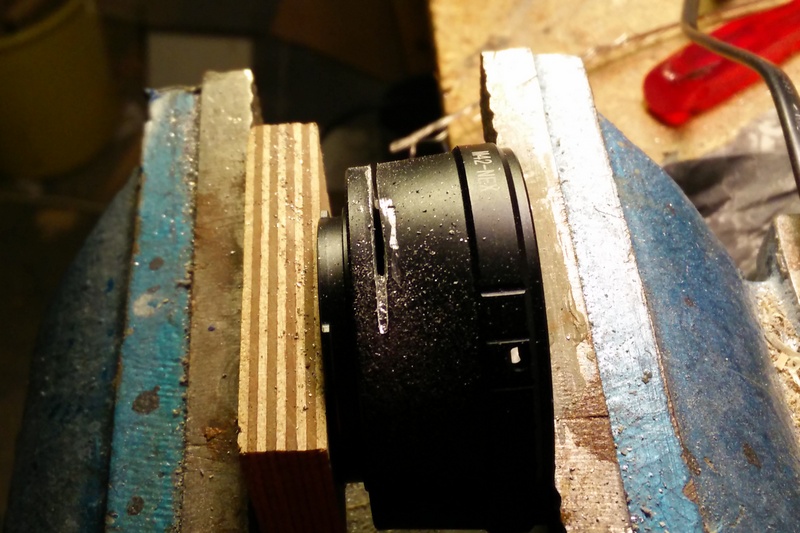
After
taking out the shutter segments the rest was a piece of cake, just add
some
external parts of the XA housing and there you are...
As
I had
already tested the optical quality when the thing was only half
assembled, I
decided to devote less time to outside appearance, because I doubt I
will ever really
use this lens.
In
essence,
as nicely as the XA camera works with film, its lens is a no-go on the
Sony
(neither on the A7R nor on the A7RII), even if the whole thing looks
funny and
almost makes the A7 pocketable.
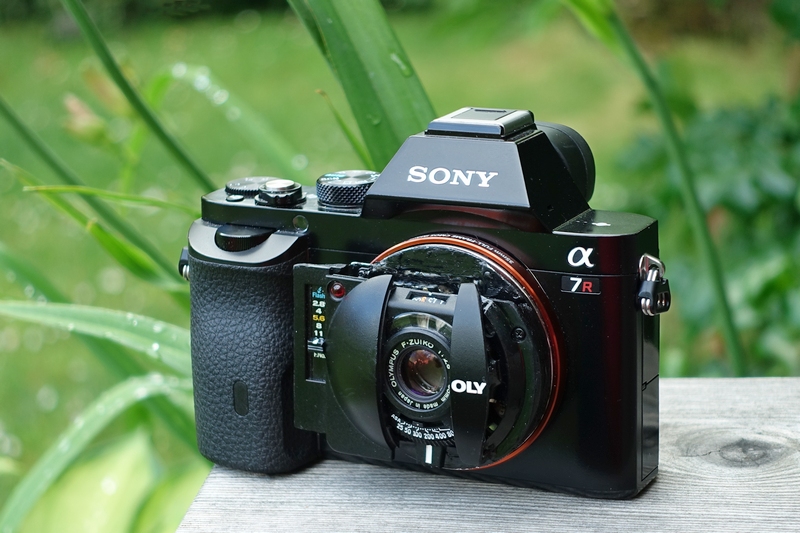
Pentax 2,8/35 from a PC35AF
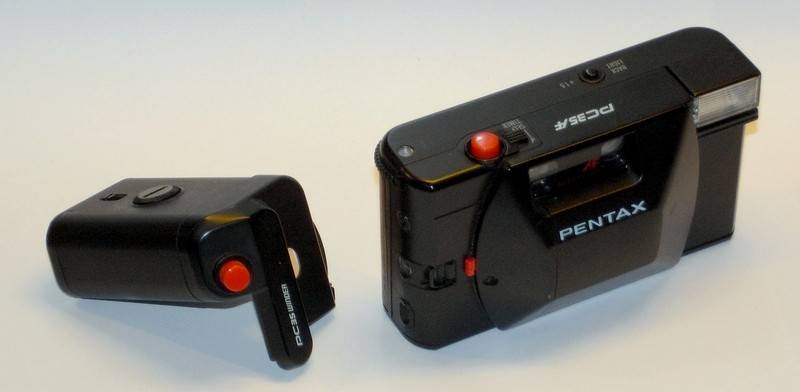
And
then
there was that old Pentax compact camera in the closet, with a lens
that had a
pretty good reputation on film. Not a stellar lens, for sure, just one
of the
early autofocus era, but one of the better ones if I remember
correctly. Here
we see the shutter placed behind the lens and no separate aperture
selection –
the programmed shutter opens the shutter more or less, depending on the
metering.
There
is
even a rather funny display of the autofocus setting in the finder:
The
number
of small springs, clips and levers to be found in this camera is pretty
remarkable. I believe electronics (of which there also is a lot) were
automatically assembled even back then, but the small parts were put
together
by human hands, I am sure.
What
a lot
of work for so little money…
A
modern
digital camera (e.g. a Sony NEX) contains a lot less parts….
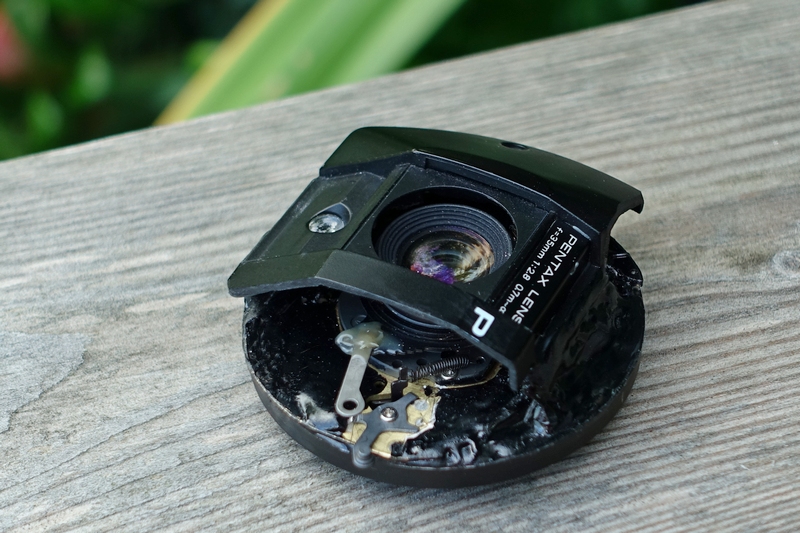
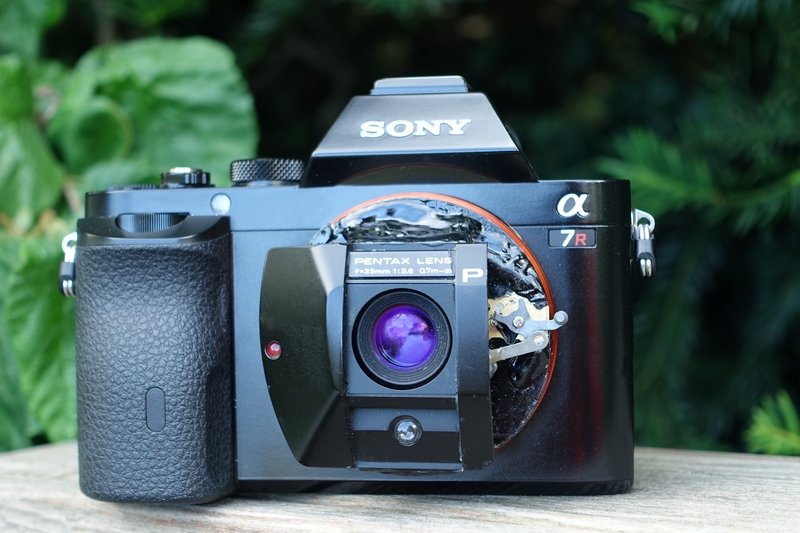
Here again, image quality is
unfortunately bad, this time not because of vignetting or color shifts,
but
because the corners are not sharp, to an extent that is beyond what can
be
found „interesting“ or „full of
character“.
Rollei Sonnar 2,3/40 from a XF 35
The
Rollei
XF35 is like a step child in the Rollei family, because it is a
purchased
camera for the most part. The lens however bears the famous
“Sonnar” name and
offers more than standard with its 1:2,3 speed and its five
elements layout.
The back focal length is a little wider than that of the two
aforementioned
lenses, so there is some hope for better optical performance.
Mechanically,
the lens has a nice focusing ring because it comes from a true
rangefinder
camera. It even has some kind of an aperture ring, meant to regulate
the
aperture depending on the distance, to provide some kind of automation
with
manual flashes, without the need for calculations. If this could be
modified to
work as a true aperture ring, the adapted lens might be quite practical
in
everyday use, maybe even nice to look at.
Unfortunately
there is no proper iris again, only two low cost sectors, so we should
not
expect nice bokeh.
Modifying
the
aperture ring turned out to be pretty difficult and the throw of the
ring is
indeed less than ideal - but the manual focusing is.
Provided
there is enough light, the optimal aperture is f=11, i.e. fully stopped
down. .
Focusing fully open (at the opposite stop) and then closed again is a
fast way
of working, and also makes sure the corners are sufficiently sharp.
Then - but
only then - this little thing is fun to use.
All
in all,
I have to admit that the appeal to adapt these lenses lies in the
process
itself. None of these old lenses comes even close to the levels of
performance
set by the Sony or Zeiss lenses originally designed for the Sony
camera.
This
may in
part be attributed to the particular likings of these sensors, who
don’t work
together well with foreign glass, certainly also to the enormous
resolution,
which makes optical flaws so very obvious, but it looks as if there has
also
been progress….
